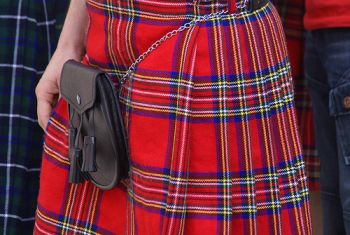Kilt
Kilt is a knee-length garment with pleats at the rear. It is believed that its originated from the traditional dress worn by men in the Scottish Higlhand of the 16th century. Since the 19th century kilt has been kind of a symbol for the Scottish or even whole Celtic culture. There is a tradition stating that “true Scotsman” wears nothing under his kilt. Kilt is a must for all those participating in Highland dancing and bagpiping.
 Scottish tartan pattern or sett
Scottish tartan pattern or sett
Kilt is usually made of woollen cloth. Scottish kilt has a tartan pattern. There are many different tartan patterns or “setts.” Until the 19th century Victorian era patterns mainly differed from region to region. Then big merchants established new system according to their own needs. Nowadays there individual pattern belonging to certain clan, family, individual, region, county or even business firm. The setts are always arranged horizontally and vertically, never diagonally. There is an exception when a cloth with tartan pattern is used for ladies' skirts. Setts also differ according to their their size, the number of inches (or centimetres) in one full repeat.
The Scottish kilt is usually worn with several accessories. They are kilt hose (woollen socks), garter flashes and a “sporran” (in Gaelic purse). The kilt hose are worn turned down at knee. The sporran is a pouch which hangs around the waist from a chain or leather strap. This may be plain or embossed leather, or decorated with sealskin, fur or polished metal plating. Other accessories you may see on a person wearing kilt are a belt, a jacket, a kilt pin, “sgian dubh” (small knife) and Ghillie brogues (traditional shoes). There are people who also wear a traditional Ghillie shirt (Jacobean or Jacobite).
Irish kilt is usually of solid colour. Irish tartan became symbol of Celtic identity at the beginning of 20th century when it was used by some Irish nationalists. In early historical documents a long Irish tunic called “Lein-croich” was often mistaken for kilt. Varieties of kilt also exist in Wales, Cornwall, northeast of England, the Isle of Man, Brittany, Normandy, Galicia, Portugal (regions of Minho and Tras-os-Montes). The most popular Welsh tartan is the St. David's tartan (in Welsh “brithwe Dewi Sant”).
It has to be said that the kilt is worn by for example Scouts, participants of the Highland Games, members of football or rugby fan group Tartan Army etc. It also is worn by some army units in the Great Britain, Australia, New Zeland, Canada and South Africa. Special kilts exist in the U.S. Marine Corps U.S. Coast Guard and the U.S. Air Force. Certain type of skirt in a way similar to kilt is often worn by girls as part of school uniform.